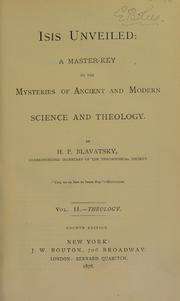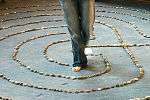Isis Unveiled
 First edition titlepage | |
| Author | Helena Petrovna Blavatsky |
|---|---|
| Country | United States |
| Language | English |
| Subject | Esoteric philosophy |
| Genre | Non-fiction |
| Published | 1877 |
| Media type | |
Isis Unveiled: A Master-Key to the Mysteries of Ancient and Modern Science and Theology, published in 1877, is a book of esoteric philosophy and Helena Petrovna Blavatsky's first major work and a key text in her Theosophical movement.
The work has often been criticized as a plagiarized occult work, with scholars noting how Blavatsky extensively copied from a large number of sources popular among occultists at the time.[1] However, Isis Unveiled is nevertheless also understood by modern scholars to be a milestone in the history of Western Esotericism.[2][3][4][5][6][7]
Overview
The work was originally entitled The Veil of Isis, a title which remains on the heading of each page, but had to be renamed once Blavatsky discovered that this title had already been used for an 1861 Rosicrucian work by W.W. Reade. Isis Unveiled is divided into two volumes. Volume I, The 'Infallibility' of Modern Science, discusses Occult science and the hidden and unknown forces of nature, exploring such subjects as forces, elementals, psychic phenomena, and the Inner and Outer Man. Volume II, Theology, discusses the similarity of Christian scripture to Eastern religions such as Buddhism, Hinduism, the Vedas, and Zoroastrianism. It follows the Renaissance notion of prisca theologia, in that all these religions purportedly descend from a common source; the ancient "Wisdom-Religion".[7] Blavatsky writes in the preface that Isis Unveiled is "a plea for the recognition of the Hermetic philosophy, the anciently universal Wisdom-Religion, as the only possible key to the Absolute in science and theology."[8]
Isis Unveiled is argued by many modern scholars such as Bruce F. Campbell and Nicholas Goodrick-Clarke to be a milestone in the history of Western Esotericism.[2] Blavatsky gathered a number of themes central to the occult tradition—perennial philosophy, a Neo-Platonic emanationist cosmology, adepts, esoteric Christianity—and reinterpreted them in relation to current developments in science and new knowledge of non-Western faiths. In doing so, Isis Unveiled reflected many contemporary controversies—such as Darwin's theories on evolution and their impact on religion—and engaged in a discussion that appealed to intelligent individuals interested in religion but alienated from conventional Western forms.[3] Blavatsky's combination of original insights, backed by scholarly and scientific sources, accomplished a major statement of modern occultism's defiance of materialist science.
In later theosophical works some of the doctrines originally stated in Isis Unveiled appeared in a significantly altered form,[note 1] drawing out confusion among readers and even causing some to perceive contradiction. Specifically, the few and—according to many—ambiguous statements on reincarnation as well as the threefold conception of man as body, soul and spirit of Isis Unveiled stand in contrast to the elaborate and definite conception of reincarnation as well as the sevenfold conception of man in The Secret Doctrine (1888). Blavatsky later asserted the correctness of her statements on reincarnation and the constitution of man in Isis Unveiled, attributing the resulting confusion and alleged contradictions to the more superficial or simplified conceptions of the ideas in Isis Unveiled compared to those of later works.[note 2][note 3]
Modern Theosophists hold the book as a revealed work dictated to Blavatsky by Theosophy's Masters.[12]
Critical reception

Detractors often accuse the book of extensive unattributed plagiarism, a view first seriously put forth by William Emmette Coleman shortly after publication and still expressed by modern scholars such as Mark Sedgwick.[13] Similarly, Geoffrey Ashe notes that Isis Unveiled combines "comparative religion, occultism, pseudoscience, and fantasy in a mélange that shows genuine if superficial research but is not free from unacknowledged borrowing and downright plagiarism."[14] Indeed, Isis Unveiled makes use of a large number of sources popular among occultists at the time, often directly copying significant amounts of text. However, rather than dwelling on the plagiarism, scholars such as Bruce Campbell argue: "Blavatsky was a person who had an original set of insights but who lacked the literary skills and knowledge of English sufficient to create a work on her own. Relying on written sources and help from friends, she formulated a unique and powerful expression of occult ideas."[3] Joscelyn Godwin and K. Paul Johnson note that early scholarship seemed obsessed with the agenda of exposing Helena Blavatsky as a plagiarist and imposter, but such labels do not properly access the Theosophical Society's place in the cultural, political, religious, and intellectual history of modern times. The work belongs to a broader movement that seeks to integrate the history of the occult sciences and of esoteric movements with more established subdisciplines.[4][5] Modern copies of Isis Unveiled are often annotated, fully delineating Blavatsky's sources and influences.
Historian Ronald H. Fritze considers Isis Unveiled to be a work of pseudohistory.[15] Likewise, Henry R. Evans, a contemporaneous journalist and magician, described the book as a "hodge-podge of absurdities, pseudo-science, mythology and folk-lore, arranged in helter-skelter fashion, with an utter disregard of logical sequence."[16] One of Blavatsky's original goals in writing Isis Unveiled and founding the Theosophical Society was to reconcile contemporary advances in science with occultism, and this synthesis was one of the main appeals of Blavatsky's work for individuals interested in religion but alienated from conventional Western forms at the time.[17][2][18] Theosophy adopted and addressed many ideas from late nineteenth century science. Some, like Darwin's theory of evolution, have continued to be accepted by the scientific community, while others, like the continent of Lemuria, though based on contemporaneous scientific theories, have long since been rendered obsolete by modern advances. Theosophy and Occultism as a whole gained a level of sophistication through the adoption of religious terms largely absent from the preceding Spiritualism movement. However, as Theosophy continued to grow as a religion, it become stuck with certain scientific ideas even after they had been discarded by the scientific community. The inability to adapt to scientific progress presents a disparity between modern Theosophy and the society's original motivations.[3] K. Paul Johnson also notes that many of the more mythical elements of Blavatsky's works, like her later Masters, rather than being outright inventions, were reformulations of preexisting esoteric ideas and the casting of a large group of individuals—who helped, encouraged, or collaborated with her—under a mythological context; all driven by Blavatsky's search for spiritual truth.[4][12]
Sten Bodvar Liljegren notes that in addition to contemporaneous occult sources and the prevailing Orientalism of the period, the novels of Edward Bulwer-Lytton heavily influenced Blavatsky's Theosophical ideas.[19]
Notes
- ↑ This shift in thought is marked by Blavatsky and the Theosophical Society's move eastward to India.[9]
- ↑ In the article Theories about Reincarnation and Spirits Blavatsky elaborately addressed the confusion related to the statements on reincarnation of Isis Unveiled, stating in particular that: "[… T]he doctrine [of reincarnation] is maintained now as it was then. Moreover, there is no 'discrepancy' but only incompleteness — hence, misconceptions arising from later teachings.".[10]
- ↑ In The Key to Theosophy Blavatsky explains that the sevenfold conception of man is the threefold conception of man, refined. In section 6, Theosophical Teachings as to Nature and Man, under the heading The Septenary Nature of Man it is asked: "Is it what we call Spirit and Soul, and the man of flesh?", to which is replied: "It is not. That is the old Platonic division. Plato was an Initiate, and therefore could not go into forbidden details; but he who is acquainted with the archaic doctrine finds the seven in Plato's various combinations of Soul and Spirit.".[11]
References
- ↑ Hart, James D; Leininger, Phillip. (1995). The Oxford Companion to American Literature. Oxford University Press. pp. 71-72. ISBN 0-19-506548-4 "After a period of spiritualism in America, Mme Blavatsky with the aid of Colonel Henry S. Olcott founded her Theosophical Society and published Isis Unveiled (1877), a plagiarized occult work denouncing the spiritualism she had formerly advocated."
- 1 2 3 Goodrick-Clarke, Nicholas, The Western Esoteric Traditions: A Historical Introduction (Oxford & New York: Oxford University Press, 2008), pp. 215-217.
- 1 2 3 4 Campbell, Bruce F. Ancient Wisdom Revived: A History of the Theosophical Movement (Berkeley & Los Angeles, CA: University of California Press, 1980), pp. 34-38, 70-74.
- 1 2 3 Johnson, K. Paul. (1994). The Masters Revealed: Madame Blavatsky and the Myth of the Great White Lodge. State University of New York Press. pp. xv-x-x, 241-245. "The Western Esoteric Tradition has no more important figures in modern times than Helena Petrovna Blavatsky (1831-1891)."
- 1 2 Godwin, Joscelyn. The Theosophical Enlightenment (Albany, NY: State University of New York Press, 1994)
- ↑ Bevir, Mark. The West Turns Eastward: Madame Blavatsky and the Transformation of the Occult Tradition. Journal of the American Academy of Religion. 62.3 (1994), pp. 747-767.
- 1 2 Santucci, James A. Blavatsky, Helena Petrovna, in Dictionary of Gnosis & Western Esotericism. ed. by Wouter J. Hanegraff (Leiden & Boston: Brill, 2006), pp. 177-185.
- ↑ Blavatsky, Helena P., Isis Unveiled: A Master-Key to the Mysteries of Ancient and Modern Science and Theology (Pasadena, CA: Theosophical University Press, 1999), vol. I. p. vii.
- ↑ Helena Blavatsky: Western Esoteric Masters Series, ed. by Nicholas Goodrick-Clarke (Berkeley, CA: North Atlantic Books, 2004), pp.9-10.
- ↑ Blavatsky, H.P. (November 1886). "Theories about Reincarnation and Spirits". Articles from The Path — April 1886 to March 1896. Theosophical University Press. I (8): 232.
- ↑ Blavatsky, H.P. The Key to Theosophy. Theosophical University Press: Online Literature. ISBN 1-55700-046-8.
- 1 2 Goodrick-Clarke, Nicholas, ‘The Coming of the Masters: The Evolutionary Reformulation of Spiritual Intermediaries in Modern Theosophy’, in Constructing Tradition: Means and Myths of Transmission in Western Esotericism, ed. Andreas B. Kilcher (Leiden & Boston, MA: Brill, 2010).
- ↑ Sedgwick, Mark. (2004). Against the Modern World: Traditionalism and the Secret Intellectual History of the Twentieth Century. Oxford University Press. p. 44. ISBN 0-19-515297-2 "Isis Unveiled was extensively plagiarized from a variety of standard works on occultism and Hermeticism (134 pages from Samuel Dunlap's Sod, the Son of Man, 107 pages from Joseph Ennemoser's History of Magic, and so on)."
- ↑ Ashe, Geoffrey. (2001). Encyclopedia of Prophecy. ABC-CLIO. p. 251
- ↑ Fritze, Ronald H. (2009). Invented Knowledge: False History, Fake Science and Pseudo-Religions. Reaktion Books. pp. 41-42. ISBN 978-1-86189-430-4
- ↑ Evans, Henry R. (1897). Hours with the Ghosts, or, Nineteenth Century Witchcraft: Illustrated Investigations into the Phenomena of Spiritualism and Theosophy. Laird & Lee. p. 266
- ↑ Olcott, Henry. Old Diary Leaves: The History of the Theosophical Society, I (Adyar: Theosophical Publishing House, 1972), p. 118
- ↑ Santucci, James A. The Notion of Race in Theosophy, in Nova Religio: The Journal of Alternative and Emergent Religions, 11.3 (2008), pp. 37-63
- ↑ Bader, A. L. (1958). Through a Glass Darkly: Spiritualism in the Browning Circle by Katherine H. Porter; Bulwer-Lytton's Novels and "Isis Unveiled" by S. B. Liljegren. Victorian Studies. Vol. 2, No. 2. pp. 183-184.
Further reading
- Campbell, Bruce F. (1980) Ancient Wisdom Revived: A History of the Theosophical Movement. Berkeley & Los Angeles, CA: University of California Press.
- Farquhar, J. N. (1915). Theosophy. In Modern Religious Movements in India. Macmillan Company.
- Garrett, Edmund (1894). Isis Very Much Unveiled: Being the Story of the Great Mahatma Hoax. Westminster Gazette.
- Godwin, Joscelyn. (1994) The Theosophical Enlightenment. Albany, NY: State University of New York Press.
- Helena Blavatsky: Western Esoteric Masters Series. (2004) ed. by Nicholas Goodrick-Clarke. Berkeley, CA: North Atlantic Books.
- Johnson, K. Paul. (1994). The Masters Revealed: Madame Blavatsky and the Myth of the Great White Lodge. State University of New York Press.
- Liljegren, Sten Bodvar (1957). Bulwer-Lytton's Novels and Isis Unveiled. Lundequistka Bokhandeln.
External links
- "Isis Unveiled". Pasadena: Theosophical Society. ISBN 1557001359.
- Coleman, William Emmette (1895). "The Sources of Madame Blavatsky's Writings". Blavatsky Archives. External link in
|publisher=(help)
